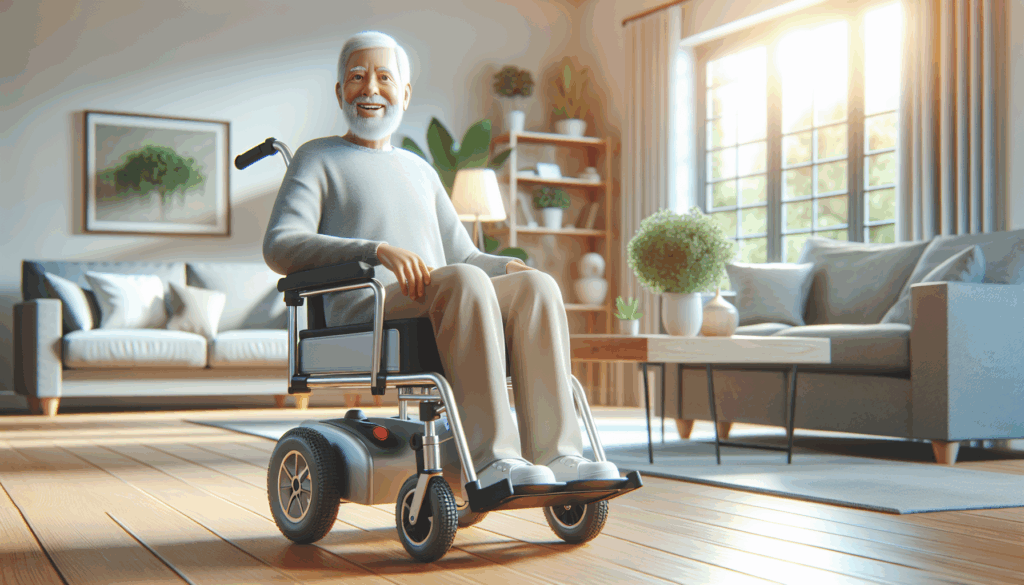
The mobility revolution has ushered in a new era of independence for individuals with disabilities, and at the heart of this transformation is the electric wheelchair. One of the most crucial aspects influencing the performance and efficiency of these devices is the type of battery they utilize. In particular, lithium-ion and lead-acid batteries each bring unique benefits and limitations to electric wheelchairs, affecting everything from range and charging time to overall weight and speed. Understanding these differences can help users select the best electric wheelchair suited to their needs, ensuring optimal mobility and freedom.
Understanding Lithium-Ion and Lead Acid Batteries
When it comes to powering electric wheelchairs, battery type plays a crucial role in determining the overall performance and efficiency of the device. Lithium-ion and lead-acid batteries are the two most commonly used types. Lithium-ion batteries are known for their lightweight, compact design and higher energy density, which allows for longer ranges per charge, as seen in models like the Edegree EW6, which offers a range of 10-15km on a single charge. This type of battery also recharges faster, taking between 6 to 8 hours, while having a significantly lower total weight of 14.8kg, making it ideal for active users who require mobility without cumbersome battery weight.
Conversely, lead-acid batteries, such as the one in the Edegree EW1 model, provide a more robust and cost-effective option. Although they weigh 38kg and have a range of around 20km, they have a longer charging time and a steeper weight, which may reduce overall mobility performance in some scenarios. Battery selection significantly impacts an electric wheelchair‘s usability and functionality. The choice between lithium-ion and lead-acid hinges on various needs like range, weight tolerance, and budget.
For instance, while lithium-ion batteries favor swift travel over versatile terrains with their climbing abilities of under 10°, lead-acid batteries allow for a higher climbing capability, up to 13°. Ultimately, understanding these differences helps users choose the right electric wheelchair that aligns with their mobility requirements, ensuring optimal performance and user satisfaction.
Benefits of Lithium-Ion Batteries in Electric Wheelchairs
Lithium-ion batteries have rapidly gained popularity in the electric wheelchair industry due to their numerous advantages over traditional lead-acid batteries. For instance, the Edegree EW6, which uses a lithium-ion battery, offers a range per charge of 10-15 km, making it a reliable choice for daily use. These batteries are significantly lighter, enhancing the overall portability of the wheelchair, as seen in the EW6’s total weight of 14.8 kg compared to the heavier Edegree EW1 at 38 kg that employs lead-acid technology. Furthermore, lithium-ion batteries generally have a longer lifespan, shorter charging time, and faster energy efficiency, which allows for quicker, regular use and less downtime for the user.
This makes them particularly beneficial for individuals who require consistent mobility assistance throughout the day. The performance impact of lithium-ion batteries extends beyond just weight and range; they also contribute to a smoother riding experience with better power delivery. Electric wheelchairs using these batteries, like the Edegree EW6, can support dual motors efficiently, providing users with reliable speeds of up to 8 km/h. The enhanced performance not only optimizes the climbing ability and speed but also reduces the overall maintenance costs related to battery replacements. Overall, the incorporation of lithium-ion batteries in electric wheelchairs represents a significant innovation, enhancing user experience through improved convenience and reliability.
Advantages of Lead Acid Batteries for Wheelchair Users
Lead acid batteries have been a reliable source of power for electric wheelchairs for many years. One of the key advantages of using lead acid batteries in electric wheelchairs is their lower initial cost compared to lithium-ion counterparts. For budget-conscious users, this can be a crucial factor. For example, the Edegree EW1 wheelchair utilizes a durable 24V 10AH lead-acid battery, allowing it to offer a decent range of approximately 20km per charge. Additionally, lead acid batteries typically have a robust construction that can withstand the physical demands of daily use, making them a solid choice for users looking for reliability and value.
While lead acid batteries may be heavier than lithium-ion batteries, their charging time tends to be efficient, averaging around 6 hours. This facilitates convenience for users who require a quick turnaround. Furthermore, the performance characteristics of lead acid batteries can make them ideal for electric wheelchairs designed to tackle moderately steep terrains, such as the Edegree EW1, which has a climbing ability of up to 13° degrees. Ultimately, the advantages of lead acid batteries in electric wheelchairs hinge on their cost-effectiveness, straightforward maintenance, and consistent performance for everyday usage.
Comparative Analysis of Lithium-Ion and Lead Acid Batteries

When it comes to electric wheelchairs, the type of battery used plays a pivotal role in determining the overall performance and user experience. Lithium-ion batteries, like the one used in the Edegree EW6, offer several advantages, including a lighter weight and a longer lifespan. Weighing just 14.8 kg, the EW6’s lithium battery allows for a more agile design and better maneuverability, crucial for users who rely on their chairs for daily mobility. Additionally, with a range per charge of 10-15 km, users can expect efficiency and reliability during their journeys. The faster charging time of 6-8 hours compared to traditional batteries enhances the convenience factor, allowing users to recharge quickly and continue their activities without prolonged downtime.
On the other hand, lead-acid batteries, such as those found in the Edegree EW1, have their merits, particularly in terms of affordability and availability. At a price of RM 2,499, this battery type, while heavier at 38 kg, offers practical benefits for users who prioritize budget over ultra-light designs. Offering a range of 20 km per charge and a decent climbing ability of 13°, the lead-acid battery serves well for mobility needs, especially in flat terrains. However, it comes with longer charging times, making it somewhat less convenient than lithium-ion systems.
Ultimately, the battery choice significantly influences not just the wheelchair’s performance but also the lifestyle and independence of its users, highlighting the importance of selecting the right power source for optimal mobility.
Impact of Battery Type on Wheelchair Performance and Range
The type of battery used in electric wheelchairs significantly influences their performance and range, directly impacting user experience. Lithium-ion batteries, as seen in the Edegree EW6 model, are lighter, allowing for a more manageable overall weight of 14.8 kg, and offer a range of 10-15 km per charge. They charge faster, in about 6-8 hours, enabling users to maximize their mobility with minimal downtime. This battery type supports better speed and weight capacity, making the wheelchair more efficient for everyday use. As a result, lithium-ion batteries enhance the overall functionality of electric wheelchairs, providing users with better climbing ability and adaptability to different terrains with less frequent charging interruptions.
On the other hand, lead-acid batteries, like those in the Edegree EW1 model, while more affordable, come with certain limitations. The heavier weight of 38 kg along with a lesser range of 20 km per charge impacts the mobility experience as they require more effort to maneuver. Although they charge in a shorter time of about 6 hours, their overall response in terms of speed (0-6 km/h) and climbing ability (13° Degree) doesn’t match that offered by lithium-ion counterparts. Thus, the choice of battery type greatly affects the usability and performance of electric wheelchairs, with lithium-ion batteries often providing a superior, more versatile option for users seeking independence and mobility efficiency.
Charging Times and Their Effect on Mobility
Charging time is a critical factor that significantly impacts the mobility and usability of electric wheelchairs. Lithium-ion batteries, such as those found in the Edegree EW6 model, generally have shorter charging times of 6 to 8 hours. This allows users to enjoy a quicker turnaround between uses, enabling more active lifestyles without lengthy delays. Their efficiency means that wheelchair users can plan their day better, ensuring they can charge their mobility aid overnight and be ready for use the next morning. The range per charge, which is about 10-15 km for the EW6, adds to the practical benefits of this battery type, especially for those who may need to travel daily.
On the other hand, lead-acid batteries, used in models like the Edegree EW1, can take around 6 hours to reach a full charge, but these batteries weigh significantly more, coming in at 38kg compared to the 14.8kg of lithium-ion models. While lead-acid batteries can offer a longer range of up to 20 km per charge, their heft can affect the overall portability of the wheelchair. For users who require a balance of power, range, and ease of transport, understanding charging time and battery type becomes essential for optimizing their electric wheelchair experience.
Weight Considerations: How Battery Type Influences Wheelchair Design
When it comes to electric wheelchairs, the type of battery used plays a significant role in the overall design and weight of the device. Lithium-ion batteries, such as those used in the Edegree EW6, are known for their lightweight characteristics, weighing in at just 14.8 kg, which allows for greater mobility and easier handling. These batteries offer a range per charge of 10-15 km, making them optimal for daily use. Their compact size and higher energy density mean that they can provide the necessary power without adding unnecessary weight to the wheelchair, thereby enhancing the user’s experience and comfort. Conversely, lead-acid batteries like those found in the Edegree EW1 are heavier, contributing to a total weight of 38 kg.
While these batteries are more budget-friendly, their weight can impact maneuverability and portability, potentially making the wheelchair more cumbersome for users who need to transport it frequently. The difference in battery weight significantly influences the overall design and functionality of electric wheelchairs. A lighter wheelchair enables easier navigation and greater convenience for users who may struggle with mobility.
In contrast, a heavier wheelchair containing lead-acid batteries might affect performance, particularly in terms of speed and endurance. Users must consider their unique needs when selecting a wheelchair; those seeking lightweight options may lean toward models using lithium-ion batteries, while budget-conscious buyers might opt for lead-acid alternatives. Ultimately, the choice between battery types shapes not only the wheelchair’s weight but also the user’s mobility experience.
Future Trends in Battery Technology for Electric Wheelchairs
As electric wheelchairs evolve, so does the technology behind their batteries. The future trends in battery technology are likely to encompass advancements in energy density, charging speeds, and longevity. Lithium-ion batteries, such as those used in the Edegree EW6 model, are already demonstrating benefits with a lighter weight and faster charging time compared to traditional lead-acid batteries like those found in the Edegree EW1. This shift will not only improve the mobility range but also enhance the overall user experience, allowing for longer rides and less time spent on recharging.
Furthermore, innovations like solid-state batteries promise even greater enhancements, potentially improving safety and performance compared to current lithium-ion cells. As research continues, we might also see further cost reductions, making one of the more efficient battery technologies accessible to a broader audience. By investing in cutting-edge battery advancements, manufacturers can provide electric wheelchair users with improved reliability, independence, and an overall enhanced quality of life, which is a critical consideration for individuals relying on these mobility devices every day.
Choosing the Right Battery for Your Electric Wheelchair

In summary, the choice between lithium-ion and lead-acid batteries is crucial for optimizing the performance of electric wheelchairs. Lithium-ion batteries, as seen in the Edegree EW6 model, offer a higher energy density, longer lifespan, and shorter charging time, making them an excellent option for those requiring extended mobility and higher speed. Their lightweight nature further enhances the overall maneuverability of the wheelchair, ensuring a seamless riding experience for users.
Conversely, lead-acid batteries, like those in the Edegree EW1, still provide a reliable and cost-effective solution, particularly for lower-speed applications, highlighting the trade-offs between weight, performance, and price that users must consider when selecting an electric wheelchair. As technology advances, it is vital for users and caregivers to stay informed about the benefits and limitations of each battery type. The battery not only influences the range and speed of the electric wheelchair but also plays a significant role in the unit’s overall weight and handling capabilities. Ultimately, the decision should be aligned with lifestyle needs, usage patterns, and budget considerations to ensure the best fit for individual mobility requirements.
